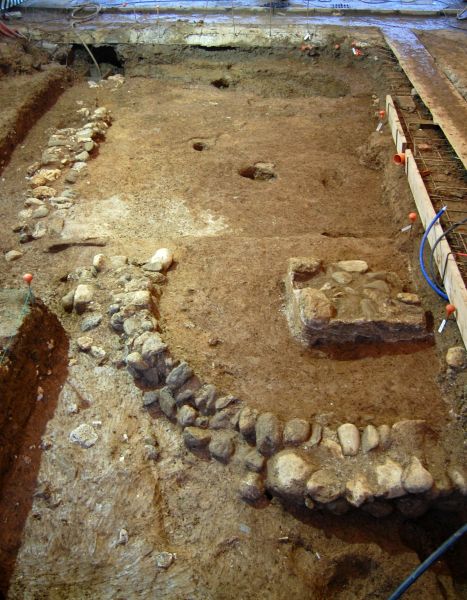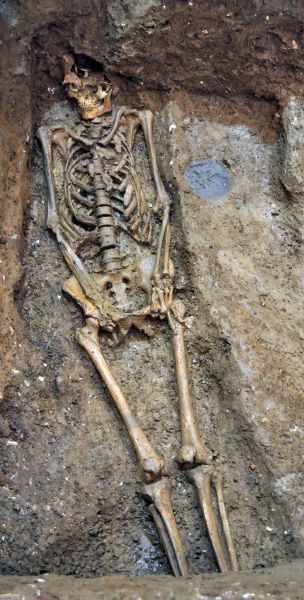Where: Camaiore - Old Town
When: IX - XV centuries
 A Church of the Early Middle Ages
A Church of the Early Middle Ages
The excavations have revealed the existence of an Early Middle Ages church, of which part of the walls and of the apse have been found (all dating back to the end of the IX century and previous to the current church of San Michele Arcangelo. The archeological data proof that, after a first period of frequentation of the place between VII and IX centuries, at the end of the IX century a little church of which there is no trace in archive documents was built.
The building had walls of clay pebbles and a semicircular apse; inside, a step separated the presbitery area (reserved for the priest) and the nave (for the parishioners). The nave floor was made with little river pebbles embedded in the ground. In the middle of the apse there was the base of the altar. It was covered with a white layer of lime mortar, that was also used for the apse flooring which later was restored with fragments of tile of the Roman Age.
The outside was used as a cemetery: 15 burials have been found there, all of them dug in narrow and shallow pits and arranged along the walls and near the apse; the dead were mostly adults and they were lying flat with arms along the body and hands lying on the hips. They were wrapped in cloth sheets without wooden case and without funeral equipment. One of the burials belonged to a woman that was 40-45 years old; her skeleton was found with the head near the apse of the church. Thanks to the good state of conservation it was possible to make a reconstruction of the features of the face (now exposed at the Civico Museo Archeologico of Camaiore).
Anthropological and paleonutriotional studies showed that those dead were tall individuals with a balanced nutrition rich in protein and calcium. The privileged place of burial could confirm the hypothesis that this group of people had a fairly high social status.
The Church of San Michele Arcangelo
At the beginning of XI century the little church was abandoned and around the middle of the XII century the few walls that were still up were disassembled to re-use the stones for the construction of the new church dedicated to San Michele Arcangelo, as attested in the 1180 by the archive document "Pope Alexander III's Privilege". This Church is visible today in the reconstruction realized after the bombings of World War II. The cemetery was expanded and it occupied the area of the previous church: the attested burials were arranged irregularly along the east wall and the dead were mostly babies, children and teenagers.
The construction of the hospital of San Michele (that nowadays corresponds to the current Museum of Sacred Art) dates back to the XII century. The hospital was attached to the church and it was placed along the ancient route of the Via Francigena. Via Francigena was the route that connected France and Northern Italy to Rome: on its path churches, monasteries and xenodochia (or hospitalia and hospitia, "hospitals") were built. Xenodochia were attached to the churches and they were aimed at helping the poor and the elderly and at hosting the wayfarers, too. Via Francigena was described for the first time in the archibishop Sigeric of Canterbury's travel journal, written in 990 after a pilgrimage to Rome. In the diary, Sigeric reports the 79 stages (submansiones) of his voyage: Camaiore is noted as Campmaior XXVII submansio and it is placed between Lucca (important ecclesiastical center that houses the wooden statue called Volto Santo - Holy Face) and Luni. 
The cemetery continued to be used until the second half of XV century: the pits of this phase contained mostly adults, buried very close one to each other and often placed one above the other, too (that was a custom of that period). Pilgrims and wayfarers previously admitted to the hospital were buried too, as testified by some archive documents (drafts of pastoral visits of 1348 and 1487). The documents praise the hospital for assistance and care reserved for strangers, who «are treated just as locals». The carbon analysis 14 of a sample of one of the most recent burials provided a dating of between 1360 AD and 1450 AD, coherently with the indications of archival documents. The same documents confirm that from 1500 onwards the burial of the dead in the area of the Church of San Michele Arcangelo is no longer a custom.
The Furnace
On the back of Palazzo Tori-Massoni the archaeological survey has instead allowed to highlight numerous sections of medieval walls, made with river pebbles and limestone stones bound with lime mortar. These walls race part of the perimeter of a vast quadrangular environment, with two pillars in the center, referable to a building with the main facade along today's Via IV Novembre, perhaps with a plan ground covered with archways. A second building, flanked to the previous one on the south-east side, is only visible in a small portion.
Afterwards, the buildings were demolished and all the area was covered with a soil drain very rich in ceramic fragments dating back to the late XV century. They were especially "archaic majolica" and "graffite", two ceramic productions typically found on the Renaissance table in the form of cups, plates and bowls of different sizes. The traces of malformations and inaccurate decorations found on many fragments make us think of waste from a wider production destined for commerce. Moreover, the presence of a large quantity of "rooster's paw" spacers (terracotta elements used to separate the ceramic items stacked during cooking) leads to hypothesizing the presence on the site (perhaps in the building previously described), or in the immediate vicinity , of a ceramic furnace. This hypothesis is supported by some archival documents that mention a furnace of "bona terra cotta colorata" in Camaiore, already active between 1348 and 1369 and a "colored pottery factory", owned by an inhabitant resident in Sesto San Michele , between XV and XVI centuries.

